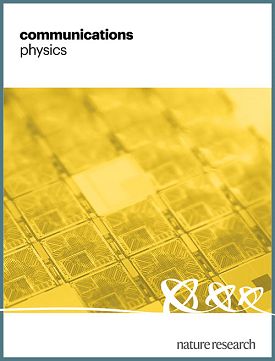A topological route to engineering robust and bright supersymmetric laser arrays
IF 5.8
1区 物理与天体物理
Q1 PHYSICS, MULTIDISCIPLINARY
引用次数: 0
Abstract
In recent years, several proposals that leverage principles from condensed matter and high-energy physics for engineering laser arrays have been put forward. The most important among these concepts are topology, which enables the construction of robust zero-mode laser devices, and supersymmetry (SUSY), which holds the potential for achieving phase locking in laser arrays. In this work, we show that the relation between supersymmetric coupled bosonic and fermionic oscillators on one side, and bipartite networks (and hence chiral symmetry) on another side can be exploited together with non-Hermitian engineering for building one- and two-dimensional laser arrays with in-phase synchronization. To demonstrate our strategy, we present a concrete design starting from the celebrated Su-Schrieffer-Heeger (SSH) model to arrive at a SUSY laser structure that enjoys two key advantages over those reported in previous works. Firstly, the design presented here features a near-uniform geometry for both the laser array and supersymmetric reservoir (i.e., the widths and distances between the cavity arrays are almost the same). Secondly, the uniform field distribution in the presented structure leads to a far-field intensity that scales as N2 where N is the number of lasing elements. Taken together, these two features can enable the implementation of higher-power laser arrays that are easy to fabricate, and hence provide a roadmap for pushing the frontier of SUSY laser arrays beyond the proof-of-concept phase. In-phase synchronization of laser arrays remains one of the most important open problems in laser science. This work utilizes the relationship between chiral symmetric tight-binding models and supersymmetry to engineer a near-uniform laser array with a superior far-field intensity scaling, extending the frontiers of laser technology.

设计坚固明亮的超对称激光阵列的拓扑途径
近年来,人们提出了几个利用凝聚态和高能物理原理的工程激光阵列的建议。在这些概念中,最重要的是拓扑,它能够构建稳健的零模激光器件,以及超对称(SUSY),它具有在激光阵列中实现锁相的潜力。在这项工作中,我们证明了超对称耦合玻色子和费米子振荡子与另一侧的二部网络(因此手性对称)之间的关系可以与非厄米工程一起利用,用于构建具有同相同步的一维和二维激光阵列。为了展示我们的策略,我们提出了一个具体的设计,从著名的Su-Schrieffer-Heeger (SSH)模型开始,到达一个SUSY激光结构,与以前的作品相比,它具有两个关键优势。首先,本文提出的设计具有激光阵列和超对称储层接近均匀的几何形状(即,腔阵列之间的宽度和距离几乎相同)。其次,所述结构中的均匀场分布导致远场强度缩放为N2,其中N为激光元素的数量。综上所述,这两个特性可以实现易于制造的高功率激光阵列,从而为推动SUSY激光阵列超越概念验证阶段提供了路线图。激光阵列的同相同步仍然是激光科学中最重要的开放性问题之一。这项工作利用手性对称紧密结合模型和超对称之间的关系来设计具有优越远场强度缩放的近均匀激光阵列,扩展了激光技术的前沿。
本文章由计算机程序翻译,如有差异,请以英文原文为准。
求助全文
约1分钟内获得全文
求助全文
来源期刊

Communications Physics
Physics and Astronomy-General Physics and Astronomy
CiteScore
8.40
自引率
3.60%
发文量
276
审稿时长
13 weeks
期刊介绍:
Communications Physics is an open access journal from Nature Research publishing high-quality research, reviews and commentary in all areas of the physical sciences. Research papers published by the journal represent significant advances bringing new insight to a specialized area of research in physics. We also aim to provide a community forum for issues of importance to all physicists, regardless of sub-discipline.
The scope of the journal covers all areas of experimental, applied, fundamental, and interdisciplinary physical sciences. Primary research published in Communications Physics includes novel experimental results, new techniques or computational methods that may influence the work of others in the sub-discipline. We also consider submissions from adjacent research fields where the central advance of the study is of interest to physicists, for example material sciences, physical chemistry and technologies.
 求助内容:
求助内容: 应助结果提醒方式:
应助结果提醒方式:


